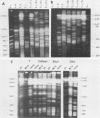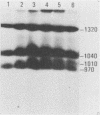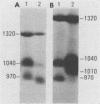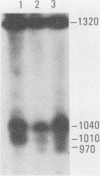Abstract
By using improved pulsed field gel conditions, the karyotypes of several strains of the protozoan parasite Trypanosoma cruzi were analyzed and compared with those of Leishmania major and two other members of the genus Trypanosoma. There was no difference in chromosome migration patterns between different life cycle stages of the T. cruzi strains analyzed. However, the sizes and numbers of chromosomal bands varied considerably among T. cruzi strains. This karyotype variation among T. cruzi strains was analyzed further at the chromosomal level by using multicopy genes as probes in Southern hybridizations. The chromosomal location of the genes encoding alpha- and beta-tubulin, ubiquitin, rRNA, spliced leader RNA, and an 85-kilodalton protein remained stable during developmental conversion of the parasite. The sizes and numbers of chromosomes containing these sequences varied among the different strains analyzed, implying multiple rearrangements of these genes during evolution of the parasites. During continuous in vitro cultivation of T. cruzi Y, the chromosomal location of the spliced leader gene shifted spontaneously. The spliced leader gene encodes a 35-nucleotide RNA that is spliced in trans from a 105-nucleotide donor RNA onto all mRNAs in T. cruzi. The spliced leader sequences changed in their physical location in both the cloned and uncloned Y strains. Associated with the complex changes was an increase in the infectivity of the rearranged variant for tissue culture cells. Our results indicate that the spliced leader gene clusters in T. cruzi undergo high-frequency genomic rearrangements.
Full text
PDF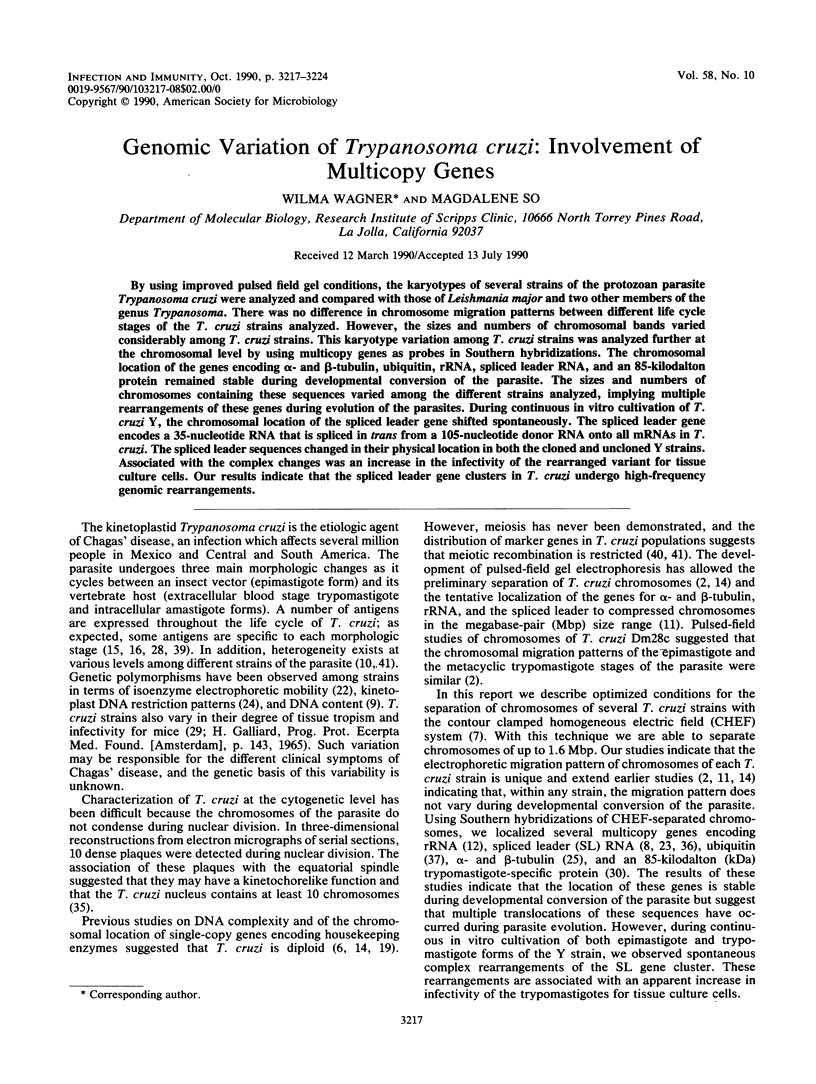
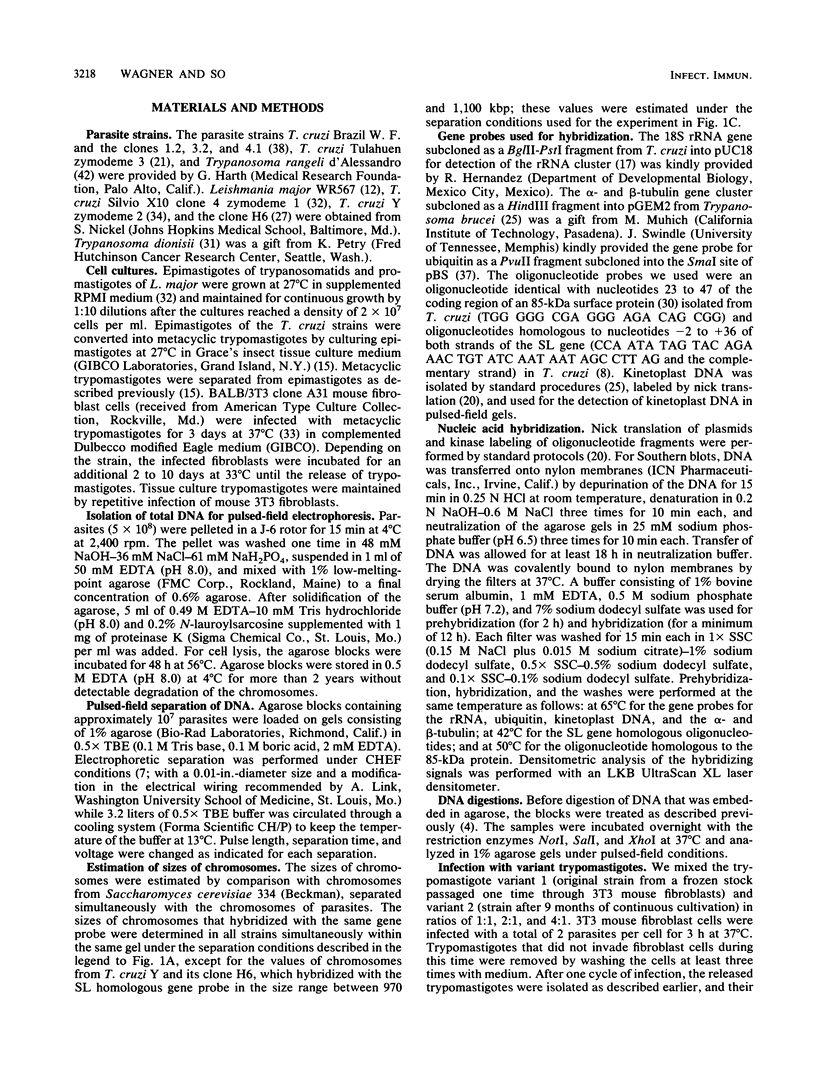





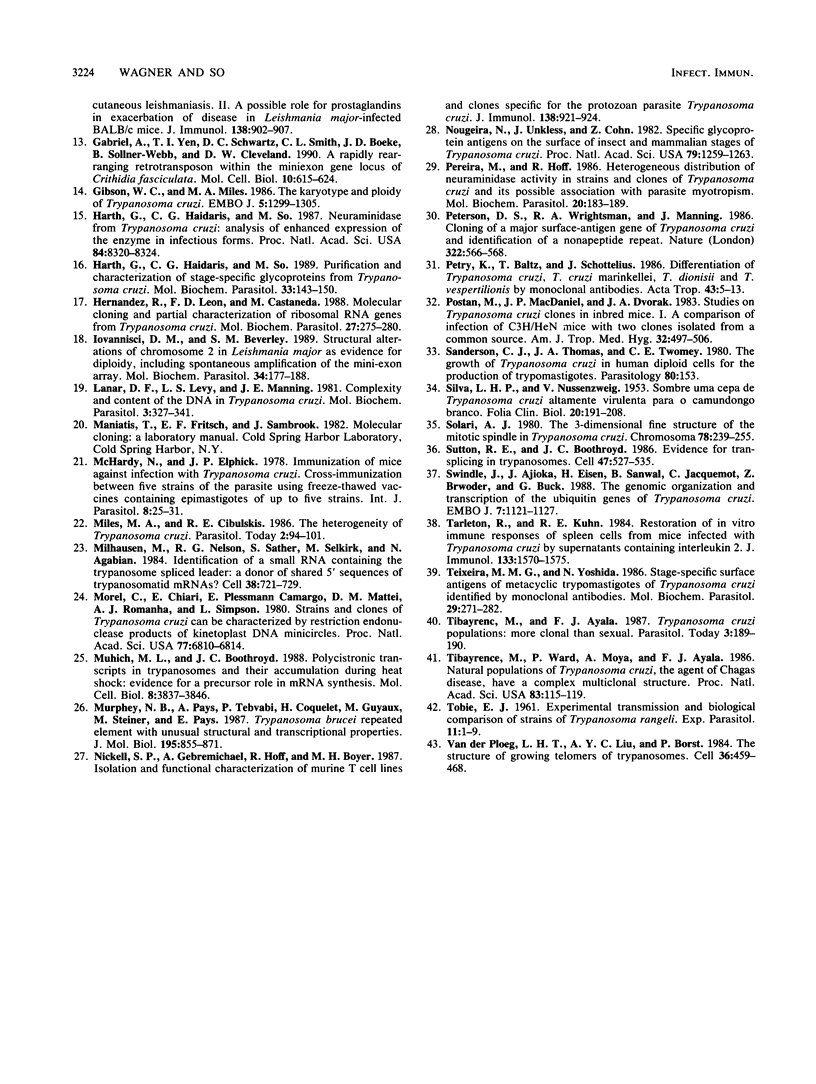
Images in this article
Selected References
These references are in PubMed. This may not be the complete list of references from this article.
- Aksoy S., Lalor T. M., Martin J., Van der Ploeg L. H., Richards F. F. Multiple copies of a retroposon interrupt spliced leader RNA genes in the African trypanosome, Trypanosoma gambiense. EMBO J. 1987 Dec 1;6(12):3819–3826. doi: 10.1002/j.1460-2075.1987.tb02718.x. [DOI] [PMC free article] [PubMed] [Google Scholar]
- Aymerich S., Goldenberg S. The karyotype of Trypanosoma cruzi Dm 28c: comparison with other T. cruzi strains and trypanosomatids. Exp Parasitol. 1989 Aug;69(2):107–115. doi: 10.1016/0014-4894(89)90178-1. [DOI] [PubMed] [Google Scholar]
- Bernards A., Michels P. A., Lincke C. R., Borst P. Growth of chromosome ends in multiplying trypanosomes. Nature. 1983 Jun 16;303(5918):592–597. doi: 10.1038/303592a0. [DOI] [PubMed] [Google Scholar]
- Beverley S. M. Characterization of the 'unusual' mobility of large circular DNAs in pulsed field-gradient electrophoresis. Nucleic Acids Res. 1988 Feb 11;16(3):925–939. doi: 10.1093/nar/16.3.925. [DOI] [PMC free article] [PubMed] [Google Scholar]
- Carrington M., Roditi I., Williams R. O. The structure and transcription of an element interspersed between tandem arrays of mini-exon donor RNA genes in Trypanosoma brucei. Nucleic Acids Res. 1987 Dec 23;15(24):10179–10198. doi: 10.1093/nar/15.24.10179. [DOI] [PMC free article] [PubMed] [Google Scholar]
- Castro C., Craig S. P., Castañeda M. Genome organization and ploidy number in Trypanosoma cruzi. Mol Biochem Parasitol. 1981 Dec 31;4(5-6):273–282. doi: 10.1016/0166-6851(81)90060-8. [DOI] [PubMed] [Google Scholar]
- Chu G., Vollrath D., Davis R. W. Separation of large DNA molecules by contour-clamped homogeneous electric fields. Science. 1986 Dec 19;234(4783):1582–1585. doi: 10.1126/science.3538420. [DOI] [PubMed] [Google Scholar]
- De Lange T., Berkvens T. M., Veerman H. J., Frasch A. C., Barry J. D., Borst P. Comparison of the genes coding for the common 5' terminal sequence of messenger RNAs in three trypanosome species. Nucleic Acids Res. 1984 Jun 11;12(11):4431–4443. doi: 10.1093/nar/12.11.4431. [DOI] [PMC free article] [PubMed] [Google Scholar]
- Dvorak J. A., Engel J. C., Leapman R. D., Swyt C. R., Pella P. A. Trypanosoma cruzi: elemental composition heterogeneity of cloned stocks. Mol Biochem Parasitol. 1988 Oct;31(1):19–26. doi: 10.1016/0166-6851(88)90141-7. [DOI] [PubMed] [Google Scholar]
- Dvorak J. A. The natural heterogeneity of Trypanosoma cruzi: biological and medical implications. J Cell Biochem. 1984;24(4):357–371. doi: 10.1002/jcb.240240406. [DOI] [PubMed] [Google Scholar]
- Engman D. M., Reddy L. V., Donelson J. E., Kirchhoff L. V. Trypanosoma cruzi exhibits inter- and intra-strain heterogeneity in molecular karyotype and chromosomal gene location. Mol Biochem Parasitol. 1987 Jan 15;22(2-3):115–123. doi: 10.1016/0166-6851(87)90041-7. [DOI] [PubMed] [Google Scholar]
- Gabriel A., Yen T. J., Schwartz D. C., Smith C. L., Boeke J. D., Sollner-Webb B., Cleveland D. W. A rapidly rearranging retrotransposon within the miniexon gene locus of Crithidia fasciculata. Mol Cell Biol. 1990 Feb;10(2):615–624. doi: 10.1128/mcb.10.2.615. [DOI] [PMC free article] [PubMed] [Google Scholar]
- Gibson W. C., Miles M. A. The karyotype and ploidy of Trypanosoma cruzi. EMBO J. 1986 Jun;5(6):1299–1305. doi: 10.1002/j.1460-2075.1986.tb04359.x. [DOI] [PMC free article] [PubMed] [Google Scholar]
- Harth G., Haidaris C. G., So M. Neuraminidase from Trypanosoma cruzi: analysis of enhanced expression of the enzyme in infectious forms. Proc Natl Acad Sci U S A. 1987 Dec;84(23):8320–8324. doi: 10.1073/pnas.84.23.8320. [DOI] [PMC free article] [PubMed] [Google Scholar]
- Harth G., Haidaris C. G., So M. Purification and characterization of stage-specific glycoproteins from Trypanosoma cruzi. Mol Biochem Parasitol. 1989 Mar 1;33(2):143–150. doi: 10.1016/0166-6851(89)90028-5. [DOI] [PubMed] [Google Scholar]
- Hernández R., Díaz-de Léon F., Castañeda M. Molecular cloning and partial characterization of ribosomal RNA genes from Trypanosoma cruzi. Mol Biochem Parasitol. 1988 Jan 15;27(2-3):275–279. doi: 10.1016/0166-6851(88)90047-3. [DOI] [PubMed] [Google Scholar]
- Iovannisci D. M., Beverley S. M. Structural alterations of chromosome 2 in Leishmania major as evidence for diploidy, including spontaneous amplification of the mini-exon array. Mol Biochem Parasitol. 1989 May 1;34(2):177–188. doi: 10.1016/0166-6851(89)90009-1. [DOI] [PubMed] [Google Scholar]
- Lanar D. E., Levy L. S., Manning J. E. Complexity and content of the DNA and RNA in Trypanosoma cruzi. Mol Biochem Parasitol. 1981 Sep;3(5):327–341. doi: 10.1016/0166-6851(81)90006-2. [DOI] [PubMed] [Google Scholar]
- McHardy N., Elphick J. P. Immunization of mice against infection with Trypanosoma cruzi. Cross-immunization between five strains of the parasite using freeze-thawed vaccines containing epimastigotes of up to five strains. Int J Parasitol. 1978 Feb;8(1):25–31. doi: 10.1016/0020-7519(78)90047-4. [DOI] [PubMed] [Google Scholar]
- Miles M. A., Cibulskis R. E. Zymodeme characterization of Trypanosoma cruzi. Parasitol Today. 1986 Apr;2(4):94–97. doi: 10.1016/0169-4758(86)90037-2. [DOI] [PubMed] [Google Scholar]
- Milhausen M., Nelson R. G., Sather S., Selkirk M., Agabian N. Identification of a small RNA containing the trypanosome spliced leader: a donor of shared 5' sequences of trypanosomatid mRNAs? Cell. 1984 Oct;38(3):721–729. doi: 10.1016/0092-8674(84)90267-8. [DOI] [PMC free article] [PubMed] [Google Scholar]
- Morel C., Chiari E., Camargo E. P., Mattei D. M., Romanha A. J., Simpson L. Strains and clones of Trypanosoma cruzi can be characterized by pattern of restriction endonuclease products of kinetoplast DNA minicircles. Proc Natl Acad Sci U S A. 1980 Nov;77(11):6810–6814. doi: 10.1073/pnas.77.11.6810. [DOI] [PMC free article] [PubMed] [Google Scholar]
- Muhich M. L., Boothroyd J. C. Polycistronic transcripts in trypanosomes and their accumulation during heat shock: evidence for a precursor role in mRNA synthesis. Mol Cell Biol. 1988 Sep;8(9):3837–3846. doi: 10.1128/mcb.8.9.3837. [DOI] [PMC free article] [PubMed] [Google Scholar]
- Murphy N. B., Pays A., Tebabi P., Coquelet H., Guyaux M., Steinert M., Pays E. Trypanosoma brucei repeated element with unusual structural and transcriptional properties. J Mol Biol. 1987 Jun 20;195(4):855–871. doi: 10.1016/0022-2836(87)90490-6. [DOI] [PubMed] [Google Scholar]
- Nickell S. P., Gebremichael A., Hoff R., Boyer M. H. Isolation and functional characterization of murine T cell lines and clones specific for the protozoan parasite Trypanosoma cruzi. J Immunol. 1987 Feb 1;138(3):914–921. [PubMed] [Google Scholar]
- Nogueira N., Unkeless J., Cohn Z. Specific glycoprotein antigens on the surface of insect and mammalian stages of Trypanosoma cruzi. Proc Natl Acad Sci U S A. 1982 Feb;79(4):1259–1263. doi: 10.1073/pnas.79.4.1259. [DOI] [PMC free article] [PubMed] [Google Scholar]
- Pereira M. E., Hoff R. Heterogeneous distribution of neuraminidase activity in strains and clones of Trypanosoma cruzi and its possible association with parasite myotropism. Mol Biochem Parasitol. 1986 Aug;20(2):183–189. doi: 10.1016/0166-6851(86)90030-7. [DOI] [PubMed] [Google Scholar]
- Peterson D. S., Wrightsman R. A., Manning J. E. Cloning of a major surface-antigen gene of Trypanosoma cruzi and identification of a nonapeptide repeat. Nature. 1986 Aug 7;322(6079):566–568. doi: 10.1038/322566a0. [DOI] [PubMed] [Google Scholar]
- Petry K., Baltz T., Schottelius J. Differentiation of Trypanosoma cruzi, T. cruzi marinkellei, T. dionisii and T. vespertilionis by monoclonal antibodies. Acta Trop. 1986 Mar;43(1):5–13. [PubMed] [Google Scholar]
- Postan M., Dvorak J. A., McDaniel J. P. Studies of Trypanosoma cruzi clones in inbred mice. I. A comparison of the course of infection of C3H/HEN- mice with two clones isolated from a common source. Am J Trop Med Hyg. 1983 May;32(3):497–506. doi: 10.4269/ajtmh.1983.32.497. [DOI] [PubMed] [Google Scholar]
- Sanderson C. J., Thomas J. A., Twomey C. E. The growth of Trypanosoma cruzi in human diploid cells for the production of trypomastigotes. Parasitology. 1980 Feb;80(1):153–162. doi: 10.1017/s0031182000000615. [DOI] [PubMed] [Google Scholar]
- Solari A. J. The 3-dimensional fine structure of the mitotic spindle in Trypanosoma cruzi. Chromosoma. 1980;78(2):239–255. doi: 10.1007/BF00328395. [DOI] [PubMed] [Google Scholar]
- Sutton R. E., Boothroyd J. C. Evidence for trans splicing in trypanosomes. Cell. 1986 Nov 21;47(4):527–535. doi: 10.1016/0092-8674(86)90617-3. [DOI] [PMC free article] [PubMed] [Google Scholar]
- Swindle J., Ajioka J., Eisen H., Sanwal B., Jacquemot C., Browder Z., Buck G. The genomic organization and transcription of the ubiquitin genes of Trypanosoma cruzi. EMBO J. 1988 Apr;7(4):1121–1127. doi: 10.1002/j.1460-2075.1988.tb02921.x. [DOI] [PMC free article] [PubMed] [Google Scholar]
- TOBIE E. J. [Experimental transmission and biological of strains of Trypanosoma rangeli]. Exp Parasitol. 1961 Feb;11:1–9. doi: 10.1016/0014-4894(61)90002-9. [DOI] [PubMed] [Google Scholar]
- Tarleton R. L., Kuhn R. E. Restoration of in vitro immune responses of spleen cells from mice infected with Trypanosoma cruzi by supernatants containing interleukin 2. J Immunol. 1984 Sep;133(3):1570–1575. [PubMed] [Google Scholar]
- Teixeira M. M., Yoshida N. Stage-specific surface antigens of metacyclic trypomastigotes of Trypanosoma cruzi identified by monoclonal antibodies. Mol Biochem Parasitol. 1986 Mar;18(3):271–282. doi: 10.1016/0166-6851(86)90085-x. [DOI] [PubMed] [Google Scholar]
- Tibayrenc M., Ayala F. J. Trypanosoma cruzi populations: more clonal than sexual. Parasitol Today. 1987 Jun;3(6):189–190. doi: 10.1016/0169-4758(87)90179-7. [DOI] [PubMed] [Google Scholar]
- Tibayrenc M., Ward P., Moya A., Ayala F. J. Natural populations of Trypanosoma cruzi, the agent of Chagas disease, have a complex multiclonal structure. Proc Natl Acad Sci U S A. 1986 Jan;83(1):115–119. doi: 10.1073/pnas.83.1.115. [DOI] [PMC free article] [PubMed] [Google Scholar]
- Van der Ploeg L. H., Liu A. Y., Borst P. Structure of the growing telomeres of Trypanosomes. Cell. 1984 Feb;36(2):459–468. doi: 10.1016/0092-8674(84)90239-3. [DOI] [PubMed] [Google Scholar]



